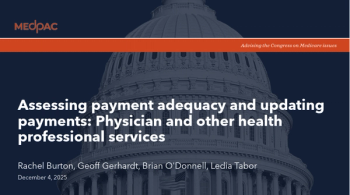
- Medical Economics October 2024
- Volume 101
- Issue 9
Malpractice strategies
Practice strategies for physicians to prevent lawsuits
Malpractice suits are something that doctors unfortunately need to be prepared for. After all, mistakes happen and sometimes patients don’t end up with the desired results, so in their minds, the doctor must be to blame.
But there are numerous safeguards physicians can engage to keep malpractice suits at bay.
Ari Gurian, founding partner of Gurian Law in Illinois whose practice represents victims of medical
“Misdiagnosis, surgical errors, medication mistakes, lack of informed consent and improper documentation are the most common causes of malpractice claims we see,” she says. “I recommend health care professionals proactively address each of these areas of vulnerability on a continuous basis as their first defense against my firm or others.”
Danielle Kelvas, M.D., a primary care physician with The HCG Institute, says from her experience, the most effective strategies in guarding against malpractice suits are to spend more time with patients and really answer their questions, including being readily available for questions or issues later.
“Everyone just wants to feel heard, cared for and appreciated,” she says. “If you can do that, patients will like and respect you and you’ll have less disagreements. Of course, conflict is unavoidable. Even if the patient was in the wrong, I always thanked them for their feedback and reemphasized that my priority is their health and that I always had their best interest at heart.”
Veronica Mishkind, a former registered nurse who is now an attorney in Coffey Modica’s medical malpractice and professional liability practices, notes that the most common cause of malpractice suits is a failure to
“The risks associated with this can be catastrophic, so in order to mitigate those risks, PCPs (primary care providers) should conduct thorough head-to-toe examinations of their patients, refer patients to specialists or further tests for any complaints the patient may present,” she says. “The PCP should also refer the patient to blood panel screenings and other standard screenings such as mammograms.”
Importantly, all of this should be documented in the PCP’s chart, including the results of the head-to-toe physical examination.
Heather Warner, health care practice lead at Woodruff Sawyer, an insurance broker and consultant, notes that a lack of knowledge, fear and an inability or refusal to change their lifestyle are the most common reasons patients pursue medical malpractice lawsuits.
“Many patients don’t want to go to the doctor or face their injury or illness, and they are intimated by medical jargon and the disparate knowledge between them and their health care providers,” she says. “However, at the same time, many patients believe that doctors can fix anything with surgery or a pill without them having to actively participate in their health.
The best way to mitigate these risks is to be kind and empathetic, to put the patients at ease and to invest them in their recovery.”
Alex Foxman, M.D., F.A.C.P., medical director at the Beverly Hills Institute, says all physicians should keep their medical knowledge up to date and ensure that they are practicing within the scope of their expertise.
“Refer patients to specialists when necessary and do not hesitate to seek second opinions when faced with complex cases,” he says. “You should also conduct regular audits of your practice to identify potential areas of risk. This includes reviewing patient records, practice protocols and communication methods to ensure they meet the highest standards.”
Mistakes to avoid
Almost half of adults in the U.S. have taken at least one prescription drug in the past 30 days. And, according to the FDA, 1.5 million patients are harmed each year by preventable medication errors. That means that they either got the wrong drug, they got too much of the drug, they had allergic reactions or there was some harmful interaction with another drug they were taking.
“My advice here is to pay attention to your patients, find out what other drugs they are taking and communicate effectively about potential risks and dosage,” Gurian says. “Each one of these injuries is preventable.”
Then there are misdiagnoses, which happen most often because of inadequate patient assessment; errors in medical judgment; failure to consider all relevant information or alternative diagnoses; and communication breakdowns within a health care team.
“To avoid a misdiagnosis malpractice lawsuit, I recommend doctors keep these risk areas in mind with every patient,” Gurian says.
Communication matters
Proper patient communication is key in preventing malpractice claims. The challenge is that not all patients feel comfortable discussing their concerns and complaints, so the PCP won’t get the correct information to make a plan of care, including further evaluation.
Therefore, PCPs should practice building their patient’s trust and rapport long term with their patients and being direct and empathetic with patients about their health, their options and their prognosis without using complex medical terms is key.
“Physicians need to take the time to make sure the patients understand what’s going on and what their treatment options are in plain, simple language, and then provide them with written notes to take home that reiterate what was discussed during their visit,” Warner says. “Research has shown that patients often forget up to 80% of what was said to them during their medical visits, so being precise is important.”
Physicians can try to foster an open and communicative relationship by trying to remember personal patient details to bring up at visits and take time during their patient’s visit to ensure that all patient concerns are addressed, fully considered and answered.
Proper documentation
Comprehensive and accurate documentation is a health care professional’s best defense against malpractice claims.
“You’d be surprised how many health care professionals keep poor records, and it only makes my job easier to win cases against them,” Gurian says. “Keep records of patient assessments, diagnoses, treatment plans and follow-ups to reduce the risk of error, and stick to established documentation protocols for maintaining electronic health records.
In litigation, Warner shares that she repeatedly hears the familiar mantra: “If it wasn’t documented, it didn’t happen” from the plaintiffs’ bar, so the importance of detailed, accurate documentation cannot be overstated.
“Physicians should be consistent in their charting, provide necessary detail, document their communications with the patient and refrain from interpersonal commentary that could be perceived as judgmental or insensitive,” she says.
From the first visit, Mishkind recommends writing down everything and anything that was discussed both with and from the patient.
“Not only should results of the physical evaluation be documented, but so should what was discussed with the patient, along with next steps and future care plans,” she says. “Further, any materials provided to the patient, including medical articles and studies, referrals, etc., should also be noted in the chart.”
At the end of each documented visit, Kelvas always adds a few sentences about how she educated the patient about what would happen if they didn’t take their medication or follow our plan of action.
“If someone is nonadherent — the old term is ‘noncompliant’ — doesn’t get their regular blood work, doesn’t refill their meds on time so there’s a lapse in care, you have to document it, otherwise, you can get dinged for a failure to follow up,” she says.
For informed consent documents, things need to be detailed and complete and include only the risks/benefits of the specific treatment being provided. The written document must be written in plain language at a seventh-grade reading level or below, and the physician needs to schedule an appointment long enough to explain everything while leaving time for questions and clarification.
Information on any treatments should be provided to the patient in their fluent language and a copy of the same should also be documented in the chart and indicated as provided to the patient.
“An informed consent document should be executed by the patient prior to any treatment or procedure,” Mishkind says.
Dealing with difficult patients
Most physicians at one time or another have run into a difficult patient relationship or someone who screams a risk of potential litigation.
When encountering someone who they think could be a challenge, Warner says physicians should slow down, have a nurse or other health care provider in the room and document.
“Though there are rare patients out there who are looking for an opportunity to sue a physician, most patients are just upset about their health issues and scared of what might happen to them, which sometimes leads to lashing out at — and blaming — their health care providers,” she says. “Empathy and patience are essential in these situations, and the physician needs to remain calm and avoid getting emotional, annoyed or angry with the patient.”
Primary care physicians need to actively listen to their patients and demonstrate that they genuinely care about their well-being. If they foster a relationship of open communication without judgment or condescension from the beginning, the barriers to patient communication, such as fear and embarrassment, will be vastly reduced and the physicians will get a more complete and accurate picture of their patients’ issues and health, making treatment plan decisions easier and more informed. That will cut down on any threats of a malpractice suit.
Articles in this issue
about 1 year ago
The medical malpractice landscape: What physicians need to knowabout 1 year ago
9 steps for medical practices to boost cybersecurity hygieneabout 1 year ago
Real estate investments will likely rise as rates fallabout 1 year ago
Five leadership tips for practicing physiciansabout 1 year ago
The cost of not knowing about type 1 diabetesabout 1 year ago
Finding solutions for physician burnoutabout 1 year ago
Direct primary care: A path to revitalizing primary careNewsletter
Stay informed and empowered with Medical Economics enewsletter, delivering expert insights, financial strategies, practice management tips and technology trends — tailored for today’s physicians.















